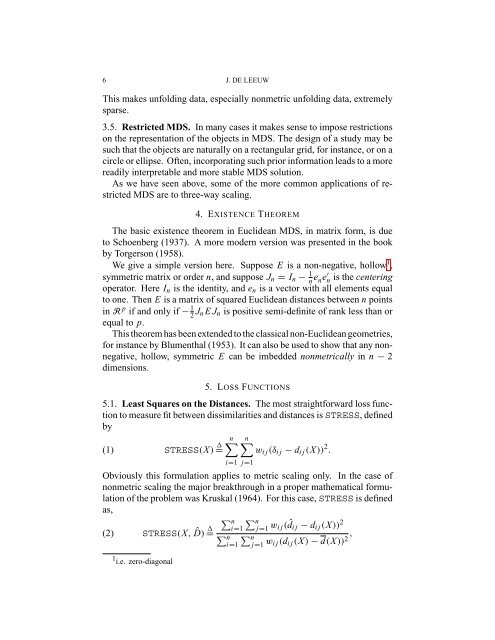Multidimensional Scaling - Convex Optimization
Multidimensional Scaling - Convex Optimization
Multidimensional Scaling - Convex Optimization
Create successful ePaper yourself
Turn your PDF publications into a flip-book with our unique Google optimized e-Paper software.
6 J. DE LEEUW<br />
This makes unfolding data, especially nonmetric unfolding data, extremely<br />
sparse.<br />
3.5. Restricted MDS. In many cases it makes sense to impose restrictions<br />
on the representation of the objects in MDS. The design of a study may be<br />
such that the objects are naturally on a rectangular grid, for instance, or on a<br />
circle or ellipse. Often, incorporating such prior information leads to a more<br />
readily interpretable and more stable MDS solution.<br />
As we have seen above, some of the more common applications of restricted<br />
MDS are to three-way scaling.<br />
4. EXISTENCE THEOREM<br />
The basic existence theorem in Euclidean MDS, in matrix form, is due<br />
to Schoenberg (1937). A more modern version was presented in the book<br />
by Torgerson (1958).<br />
We give a simple version here. Suppose E is a non-negative, hollow 1 ,<br />
symmetric matrix or order n, and suppose J n = I n − 1 n e n e′ n is the centering<br />
operator. Here I n is the identity, and e n is a vector with all elements equal<br />
to one. Then E is a matrix of squared Euclidean distances between n points<br />
in R p if and only if − 1 2 J n E J n is positive semi-definite of rank less than or<br />
equal to p.<br />
This theorem has been extended to the classical non-Euclidean geometries,<br />
for instance by Blumenthal (1953). It can also be used to show that any nonnegative,<br />
hollow, symmetric E can be imbedded nonmetrically in n − 2<br />
dimensions.<br />
5. LOSS FUNCTIONS<br />
5.1. Least Squares on the Distances. The most straightforward loss function<br />
to measure fit between dissimilarities and distances is STRESS, defined<br />
by<br />
n∑ n∑<br />
(1) STRESS(X) =<br />
w i j (δ i j − d i j (X)) 2 .<br />
i=1<br />
j=1<br />
Obviously this formulation applies to metric scaling only. In the case of<br />
nonmetric scaling the major breakthrough in a proper mathematical formulation<br />
of the problem was Kruskal (1964). For this case, STRESS is defined<br />
as,<br />
∑ ni=1 ∑ nj=1<br />
(2) STRESS(X, ˆD) =<br />
w i j ( ˆd i j − d i j (X)) 2<br />
∑ ni=1 ∑ nj=1<br />
w i j (d i j (X) − d(X)) , 2<br />
1 i.e. zero-diagonal
















